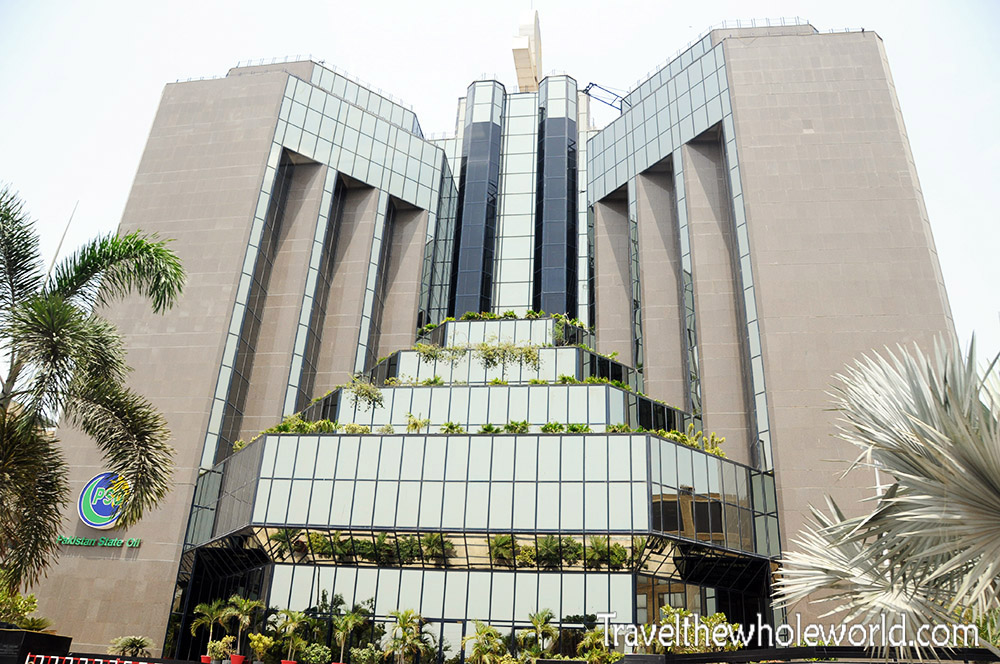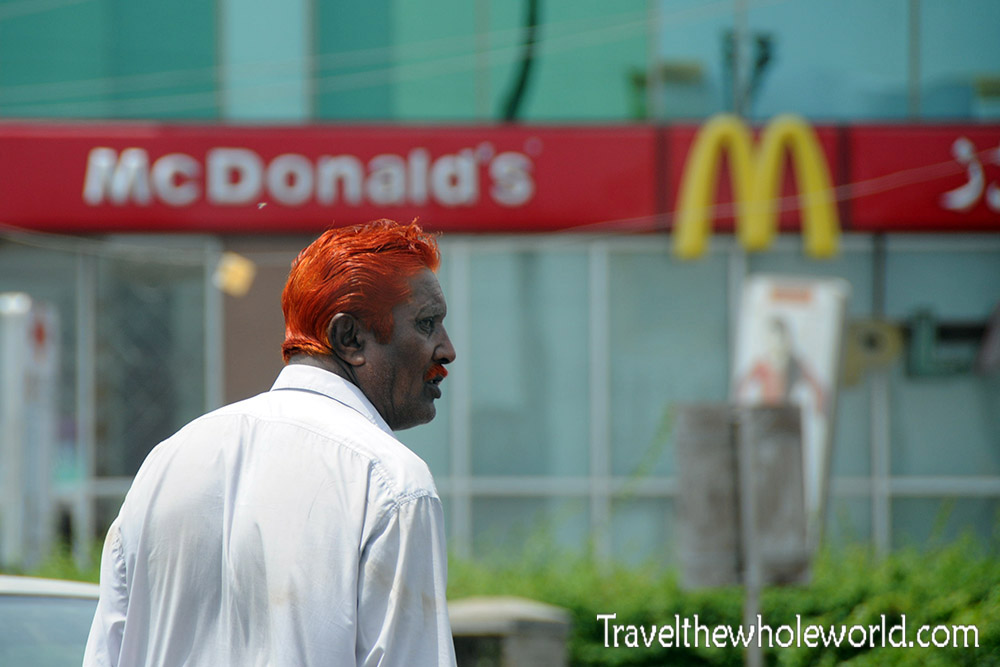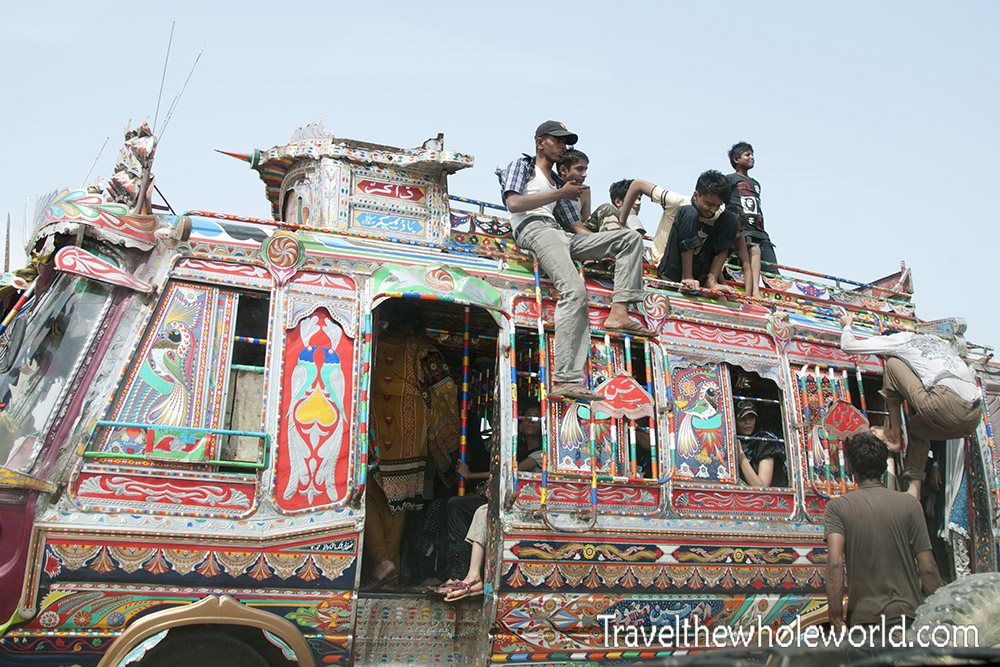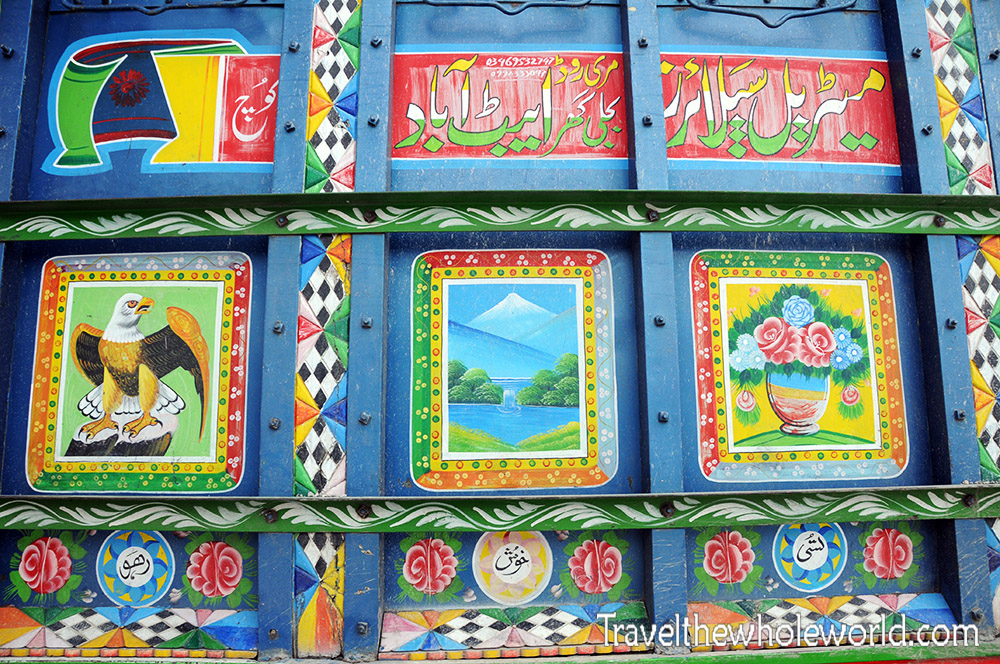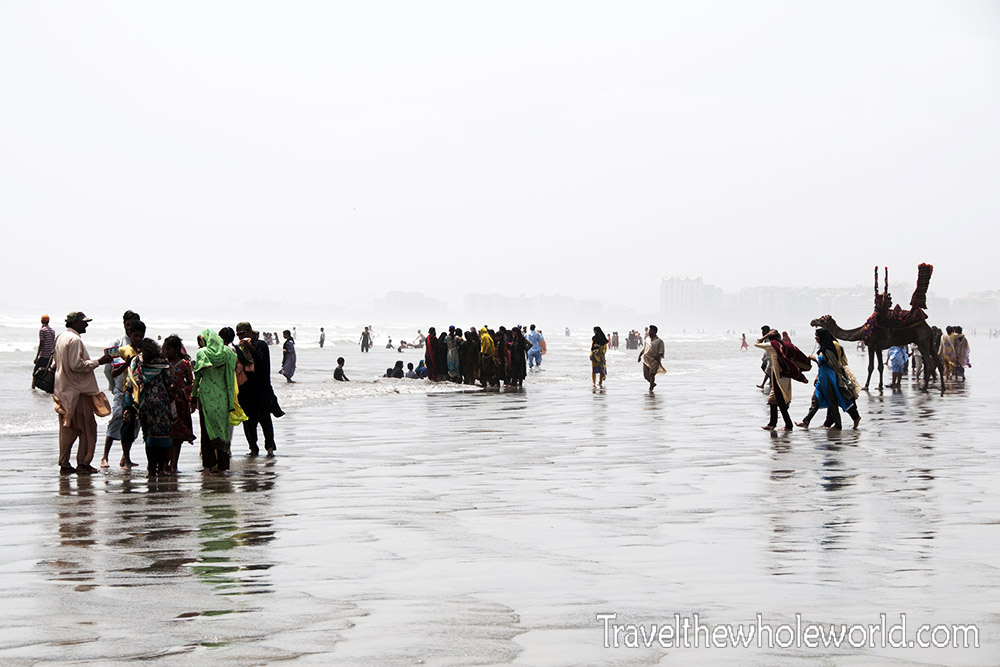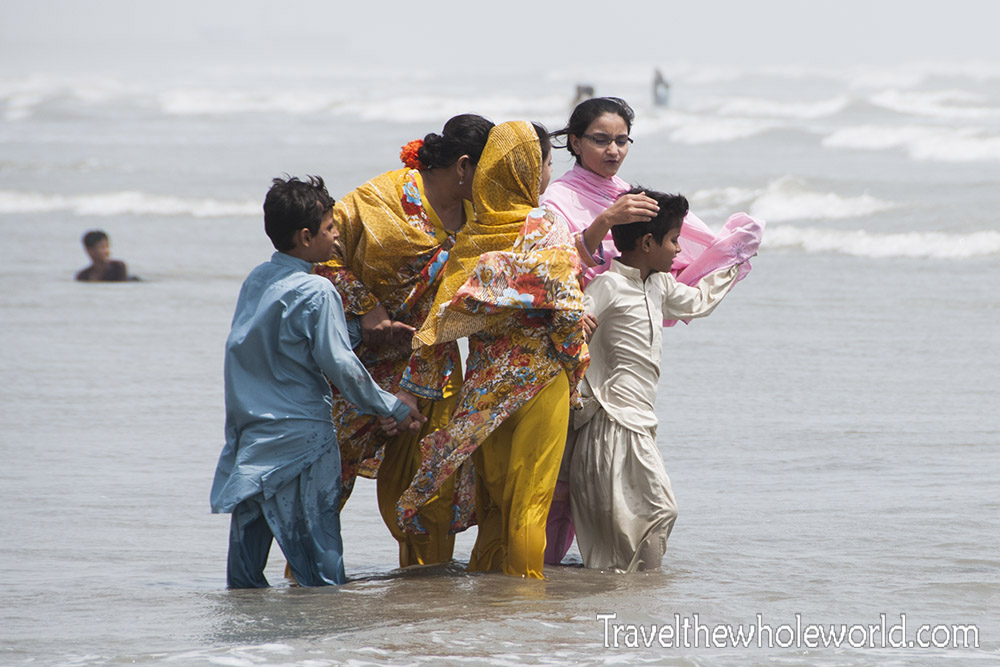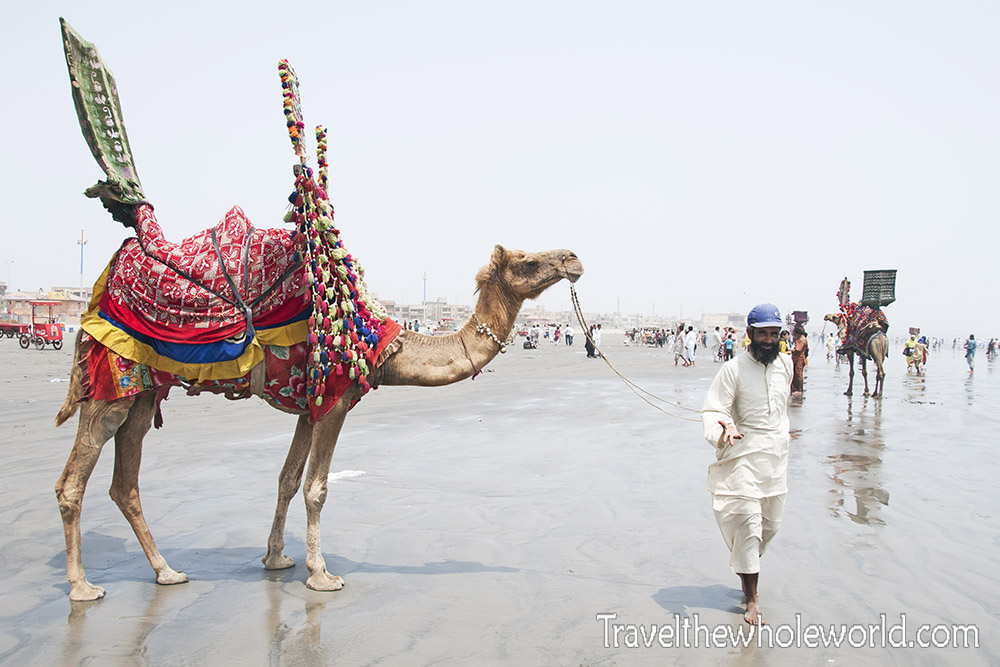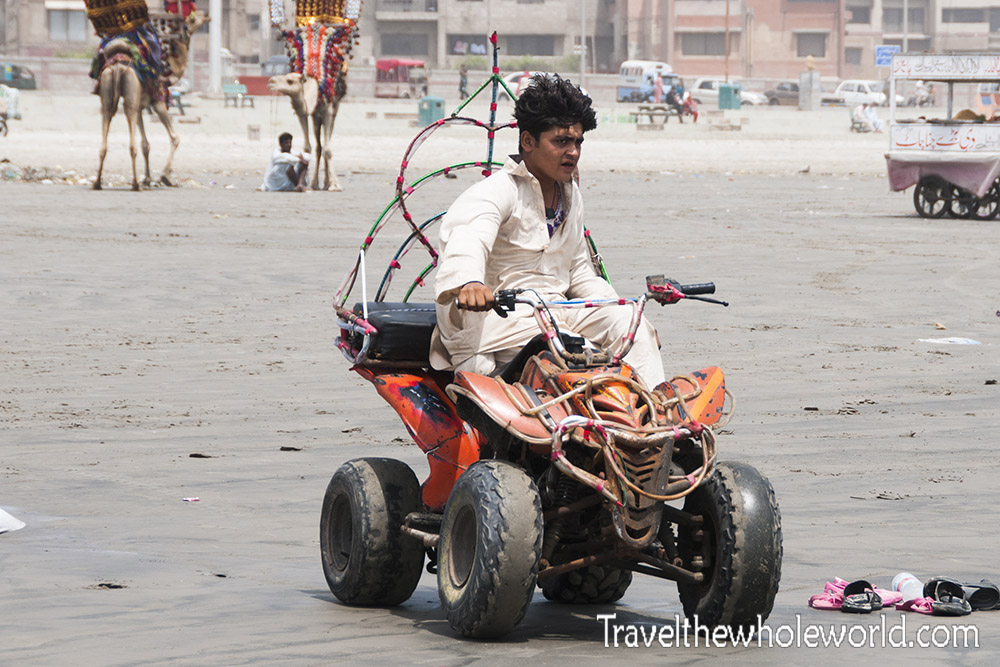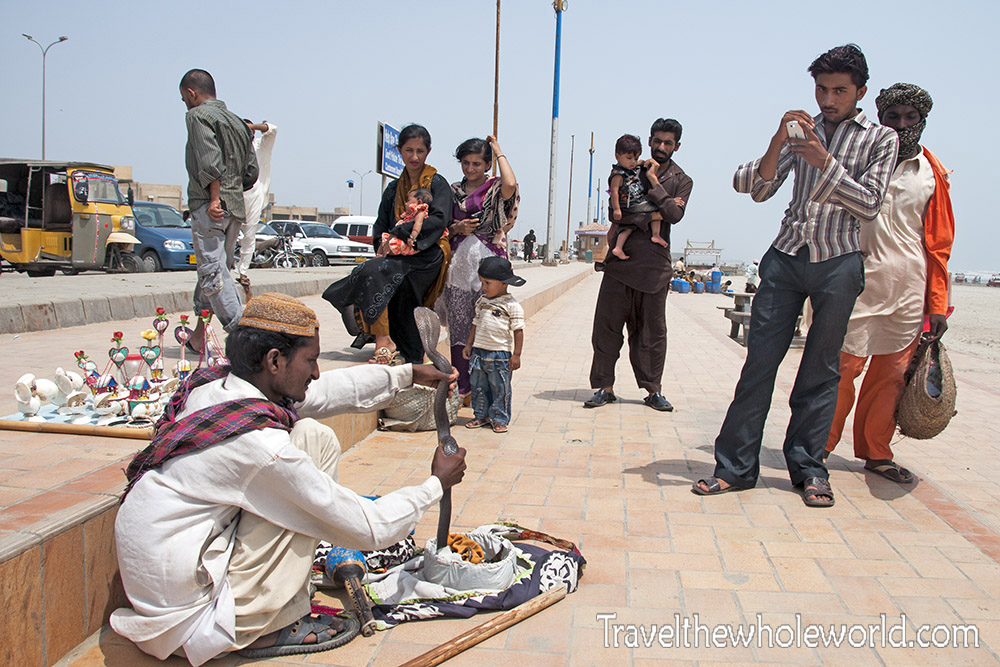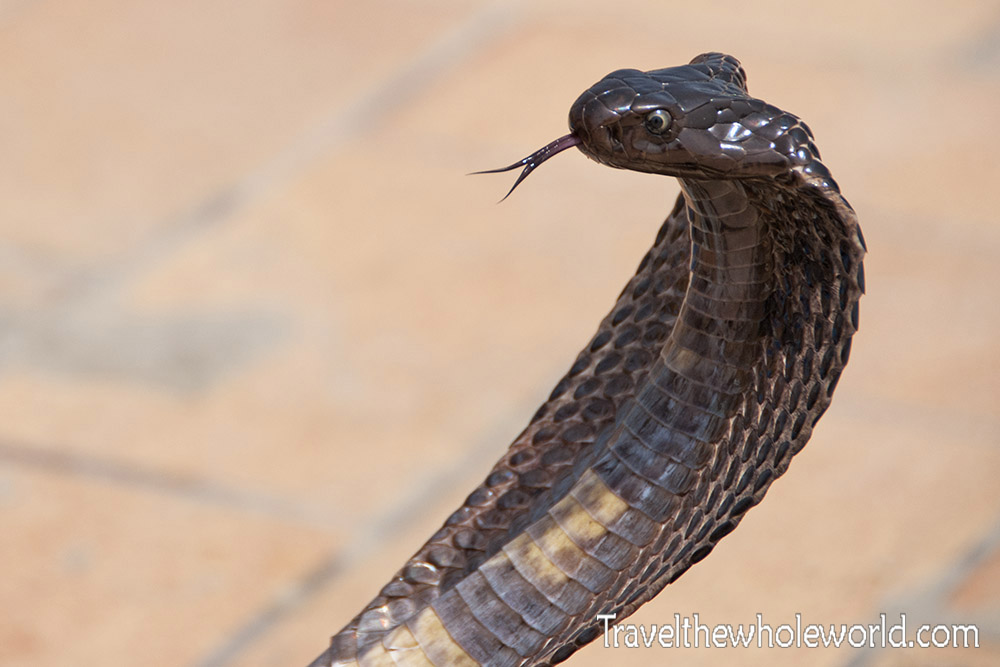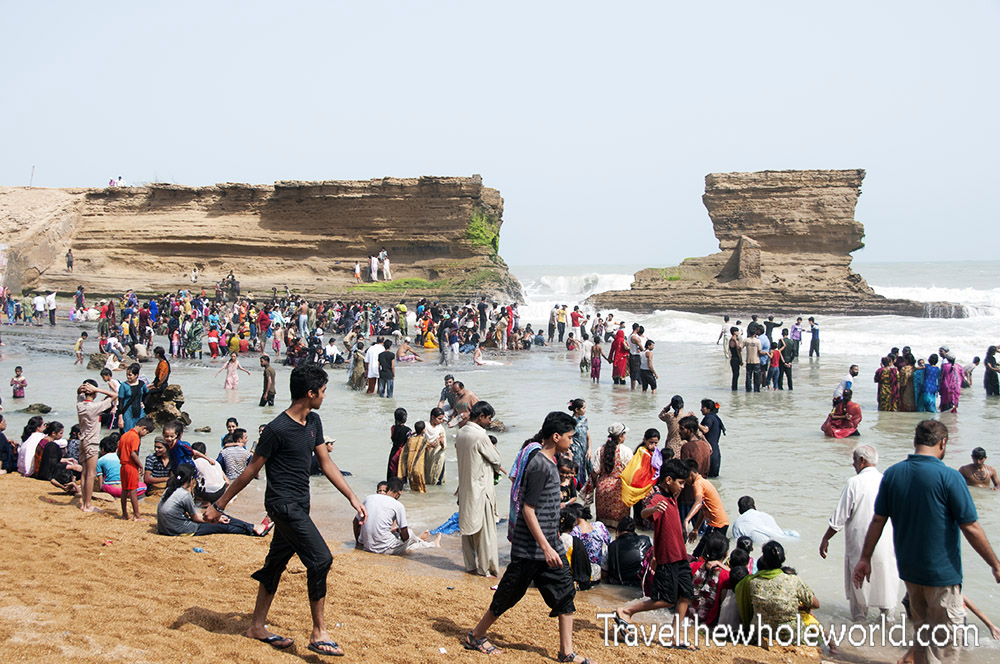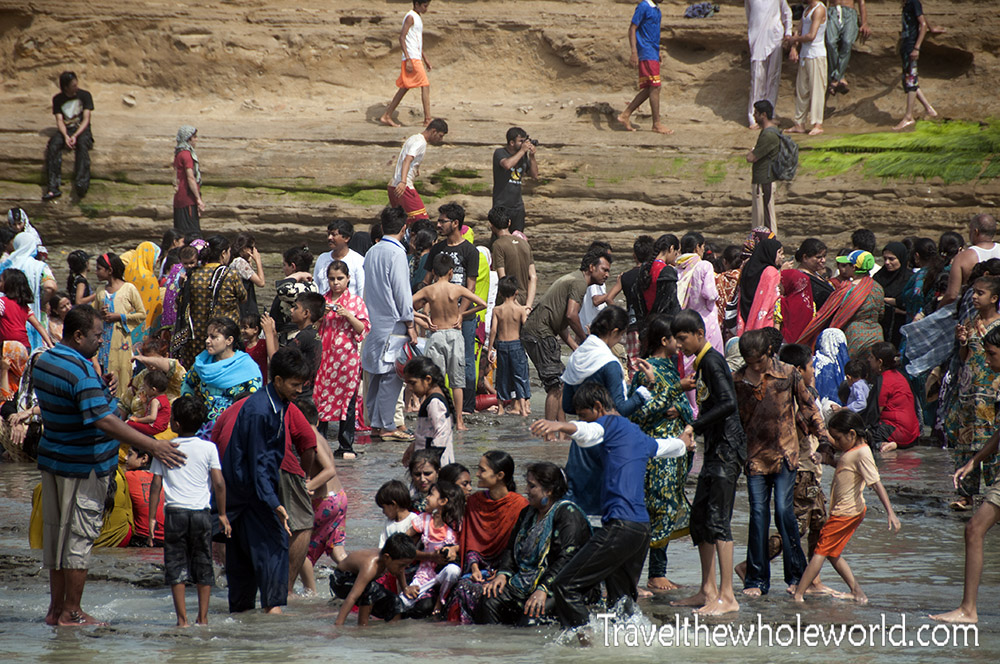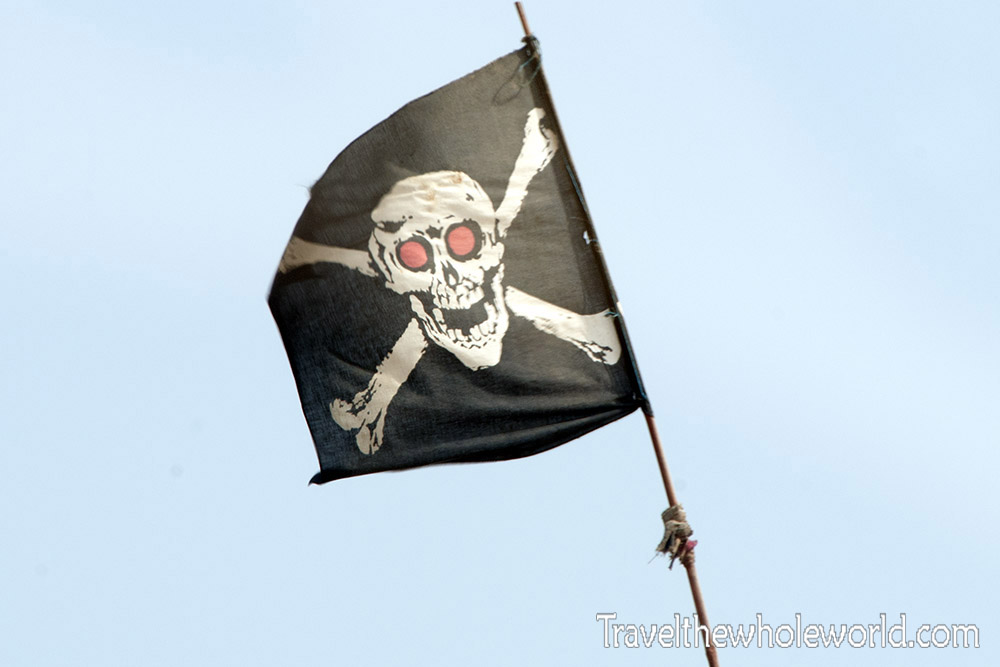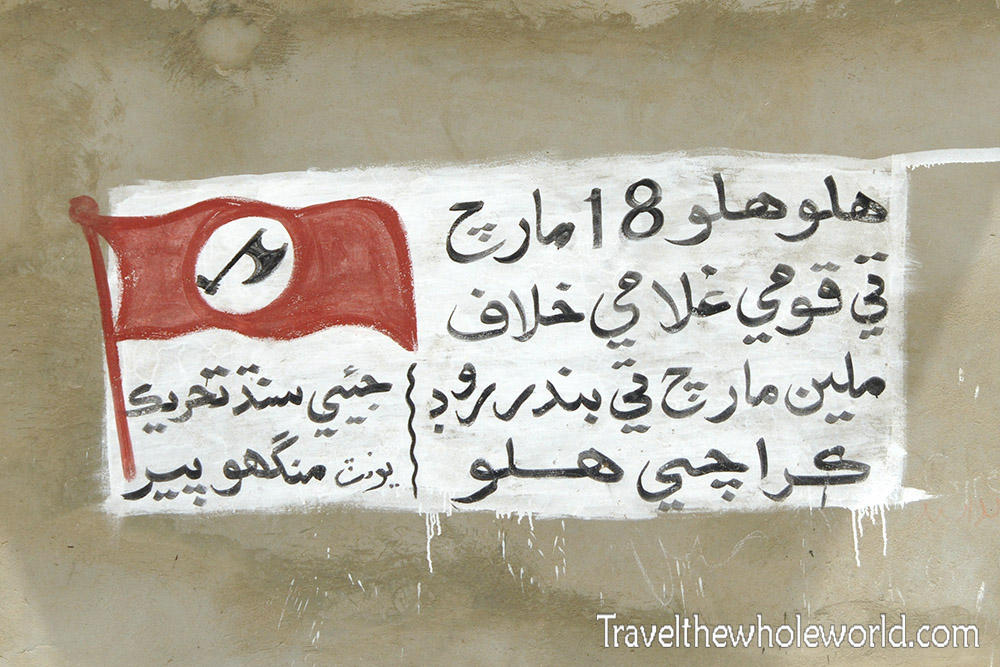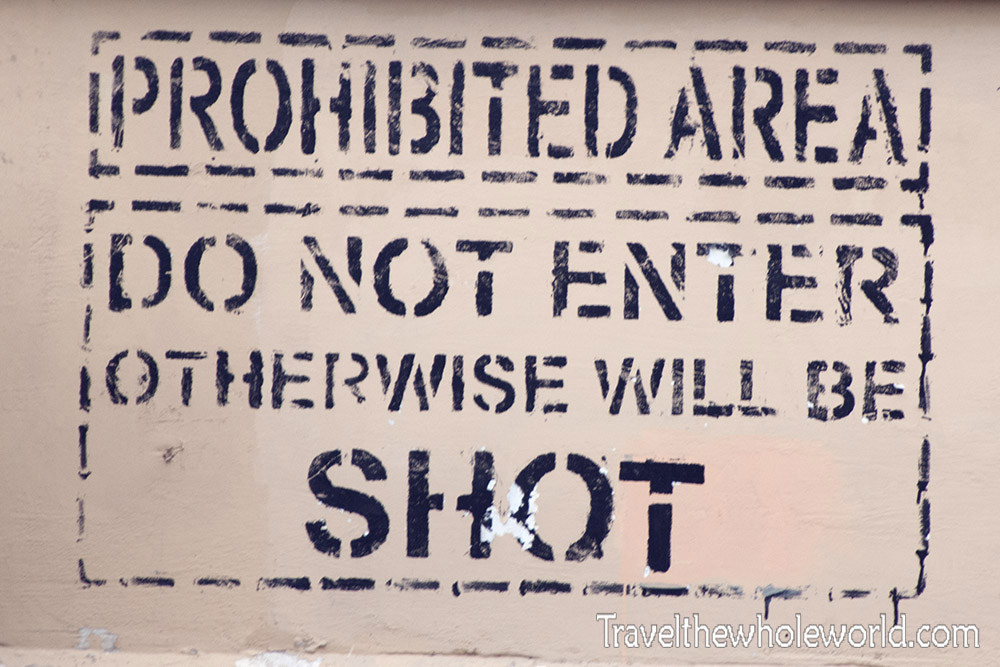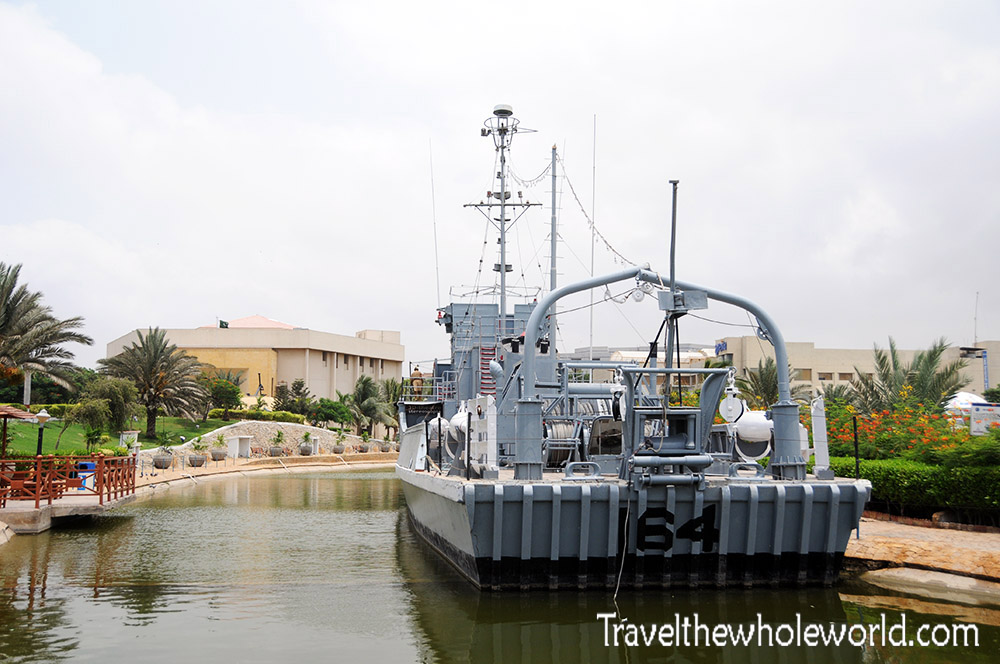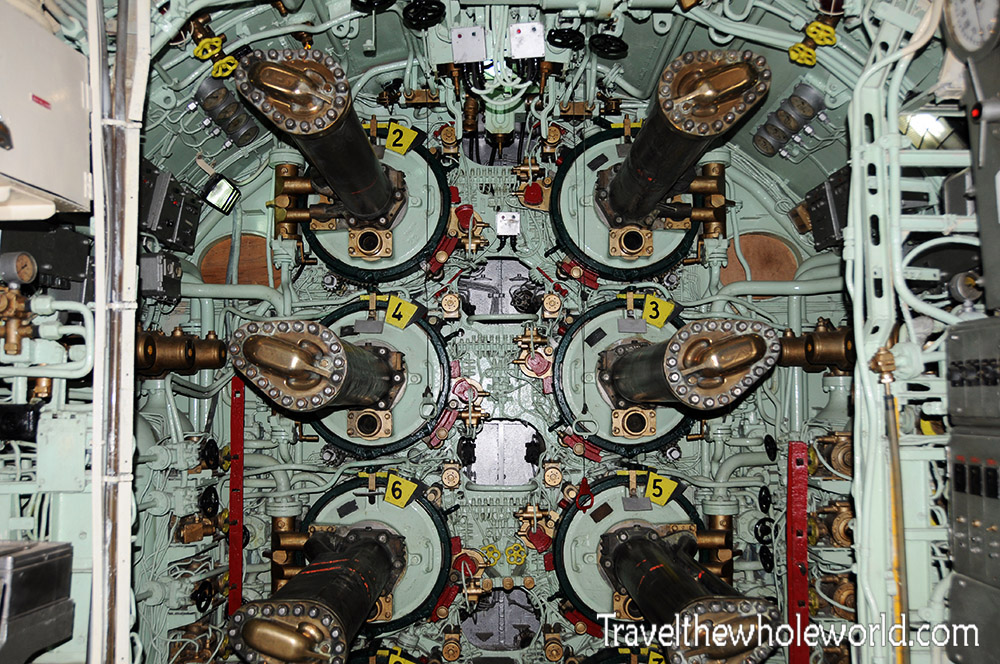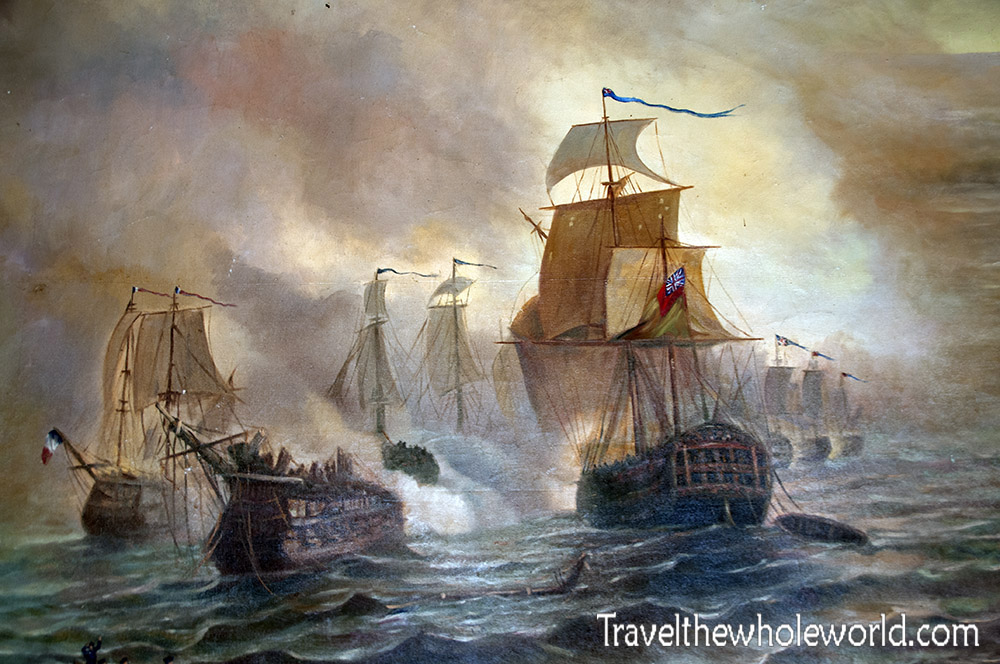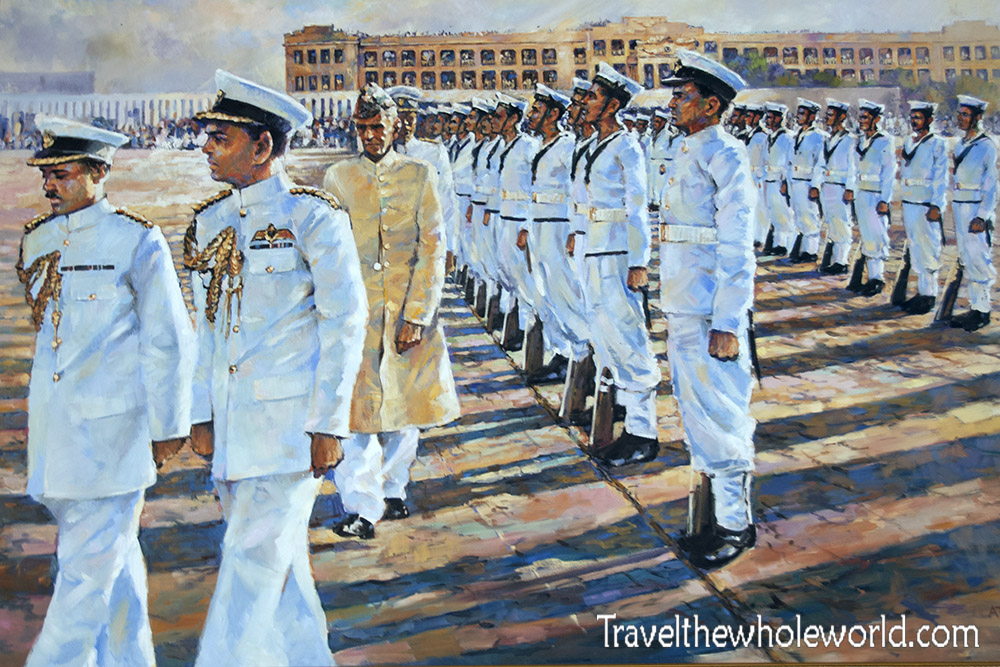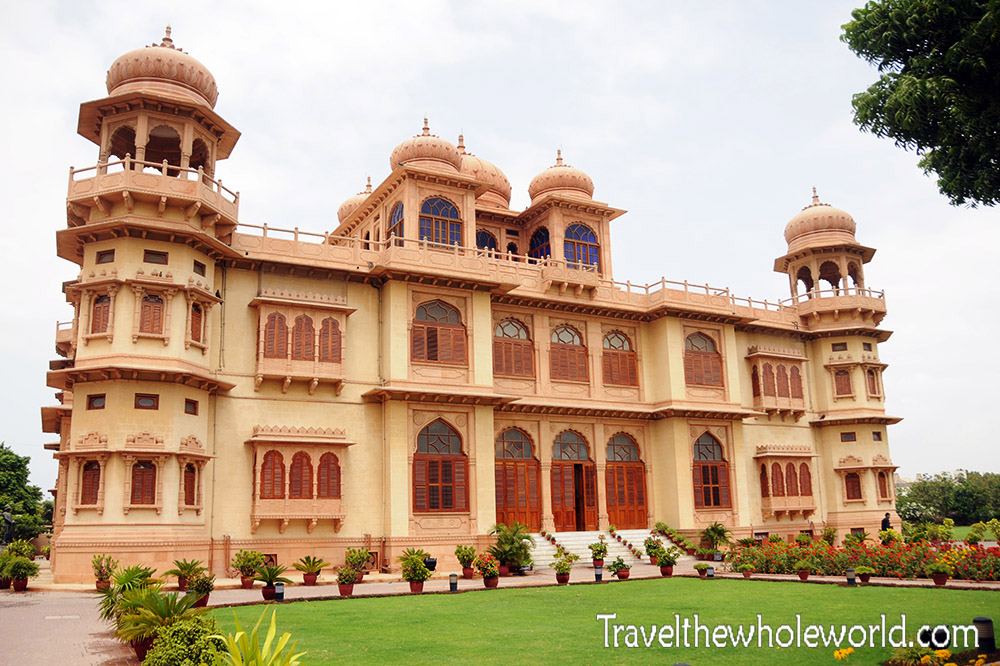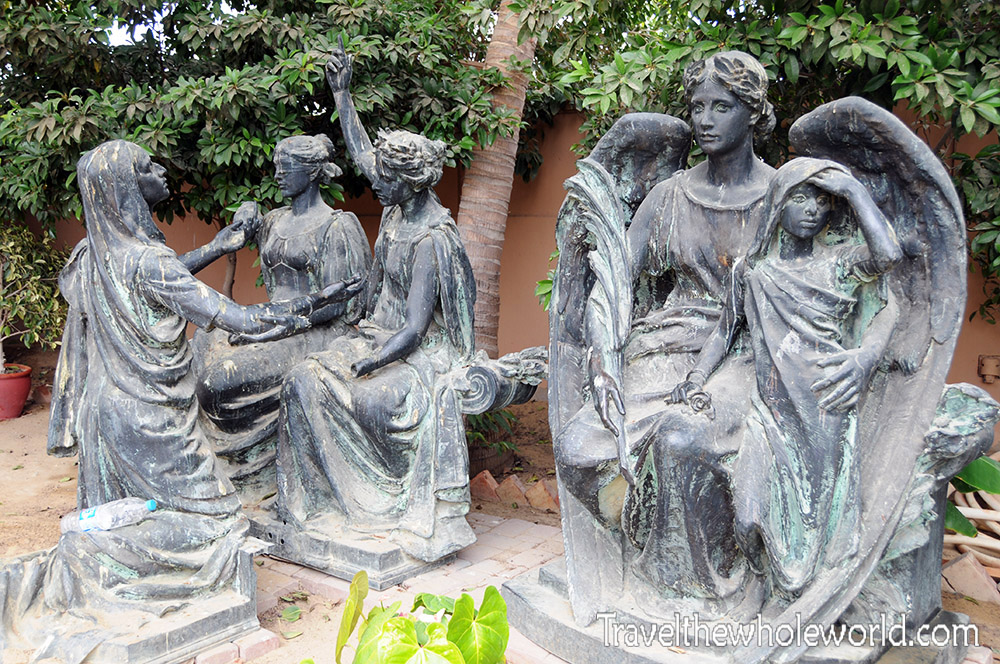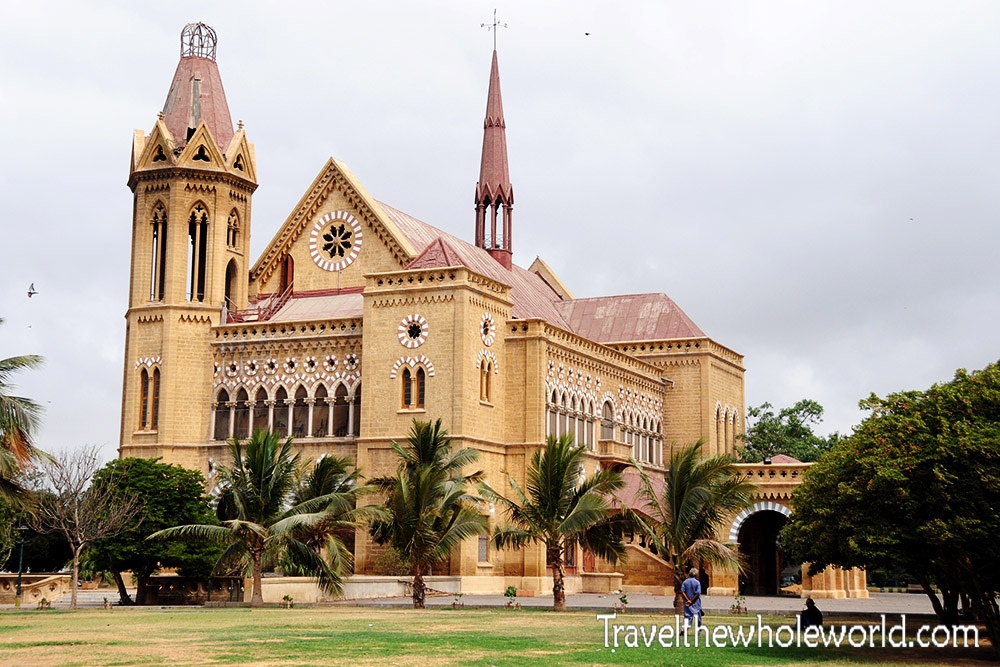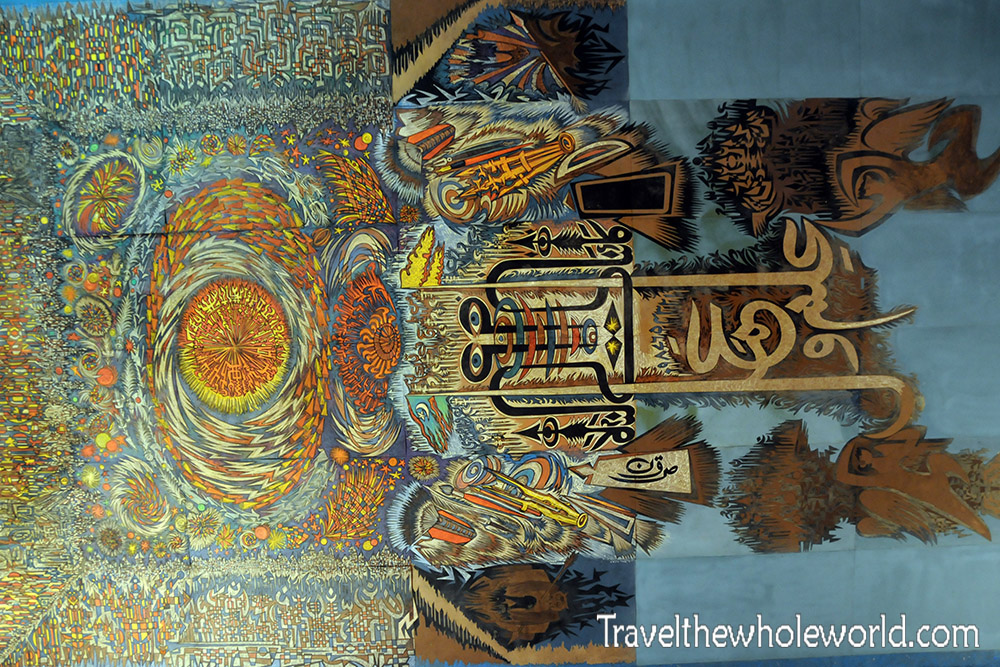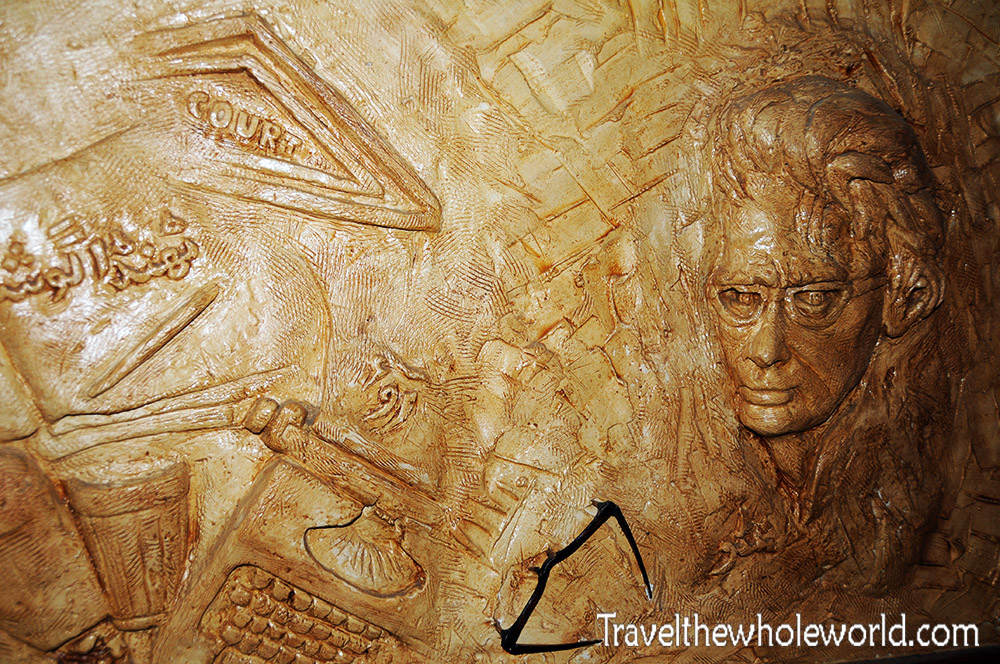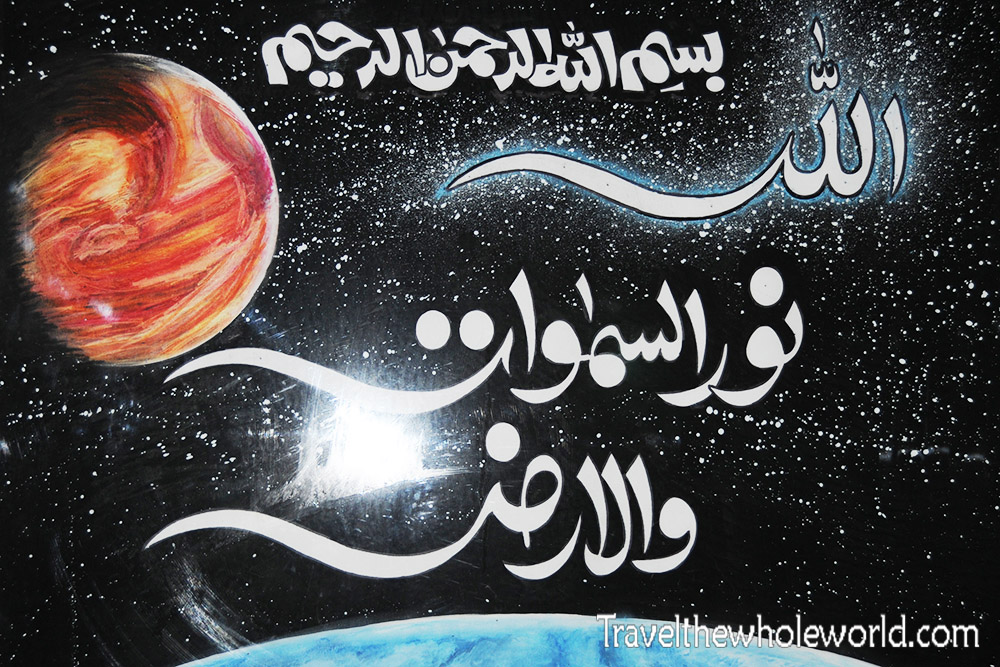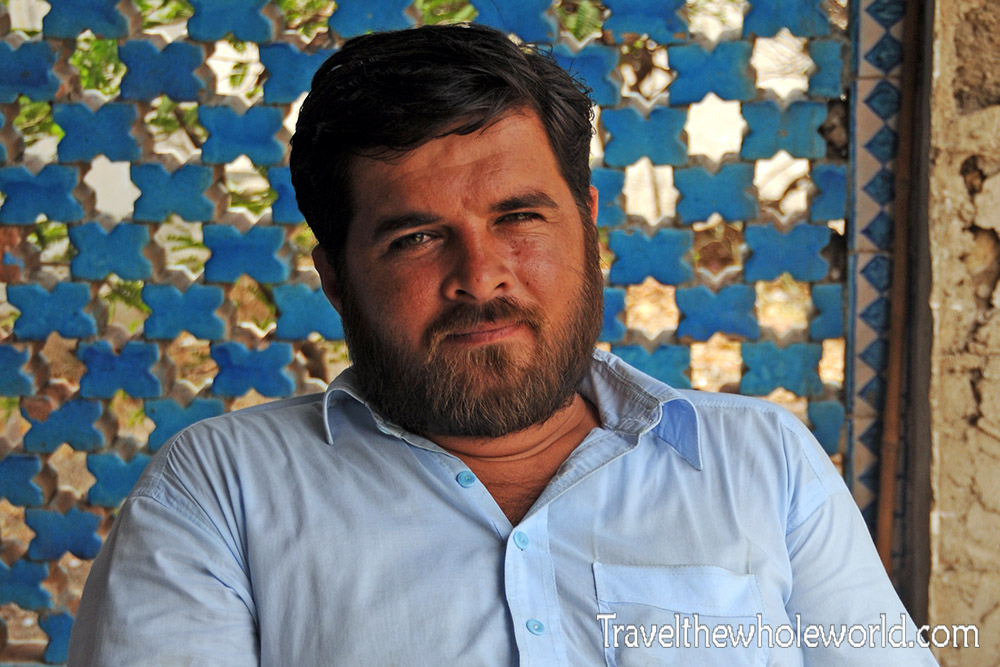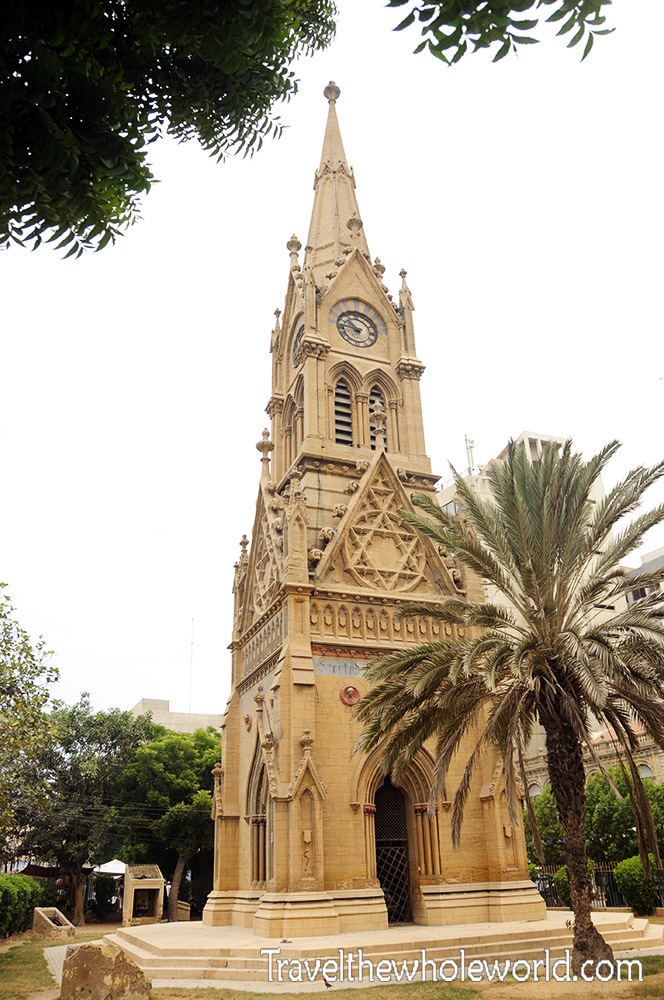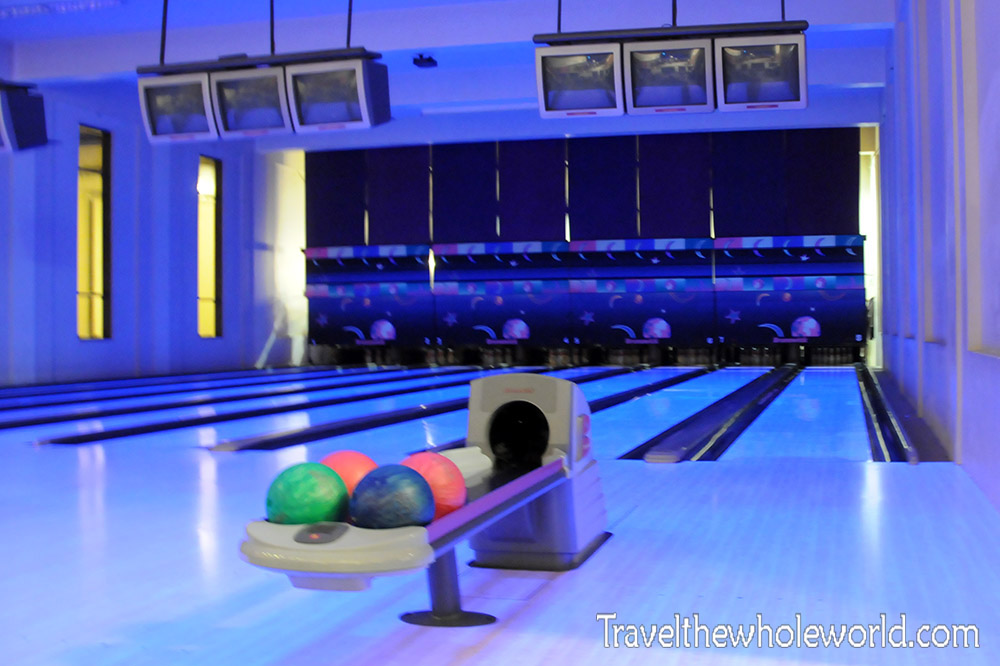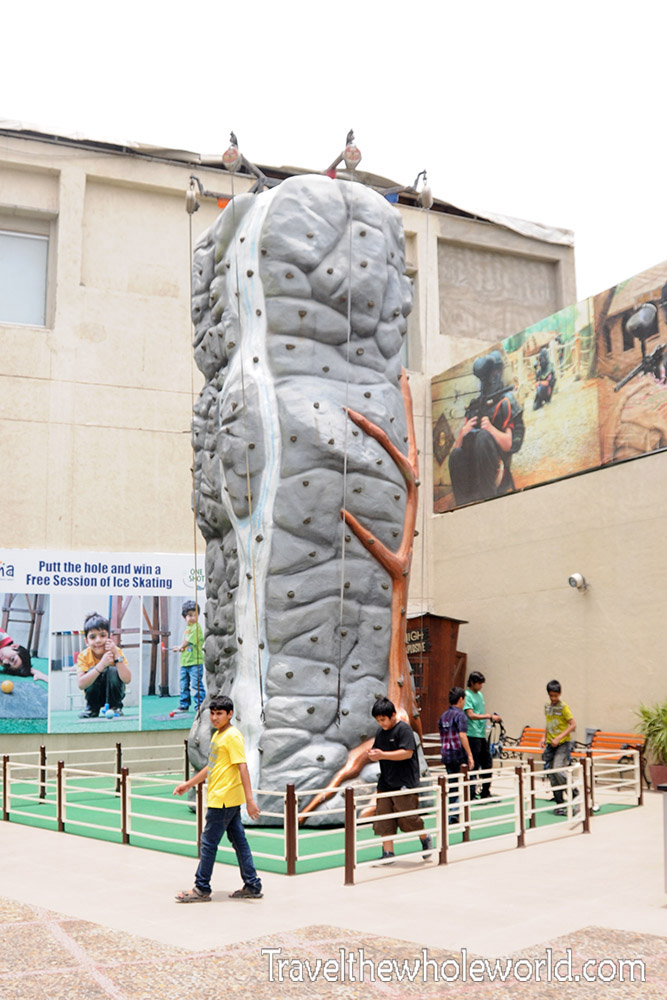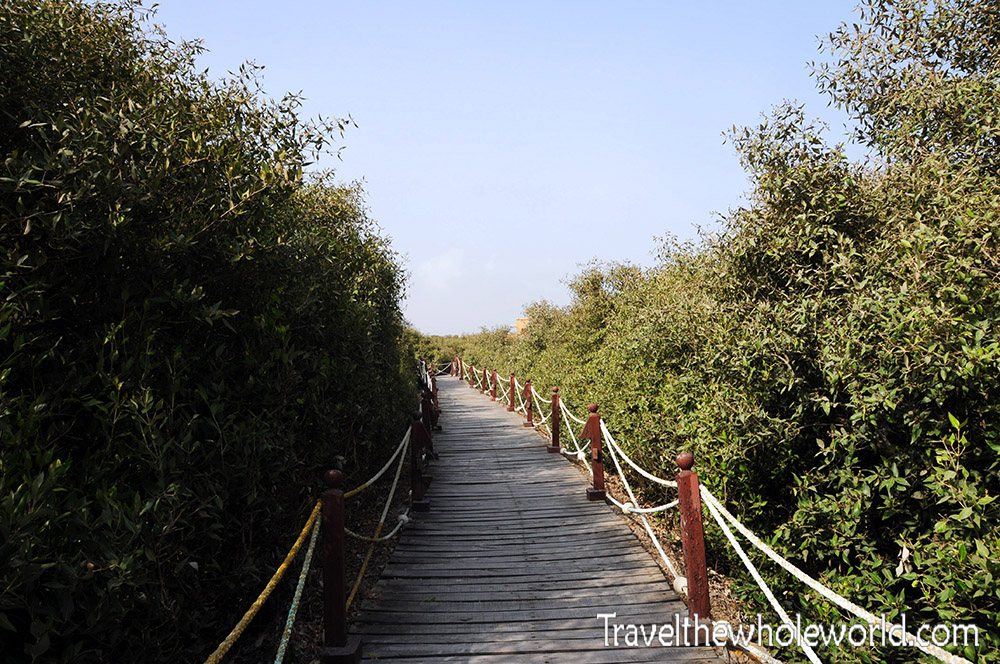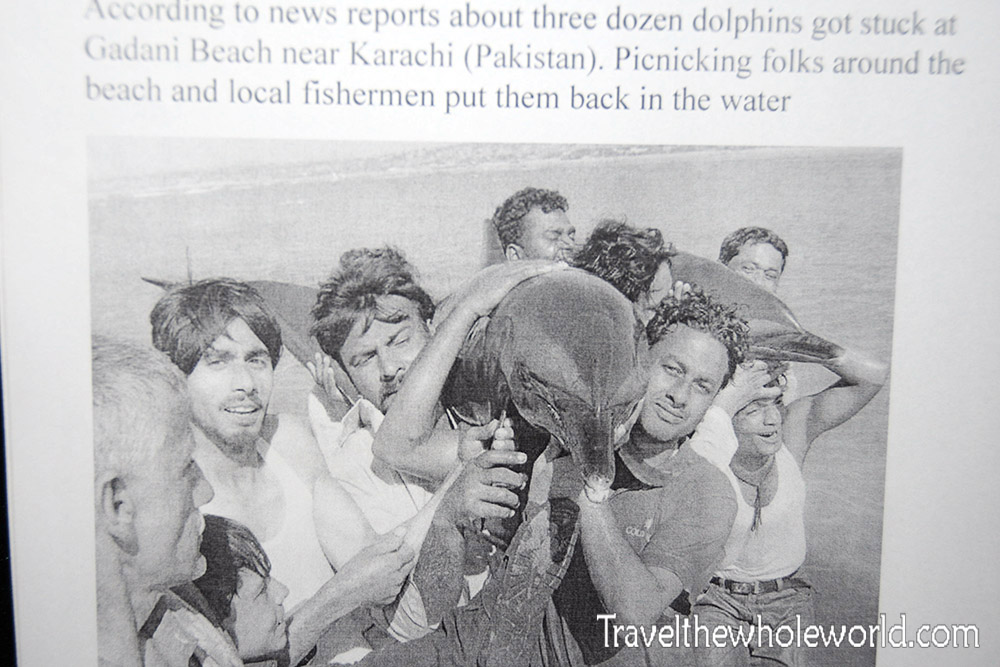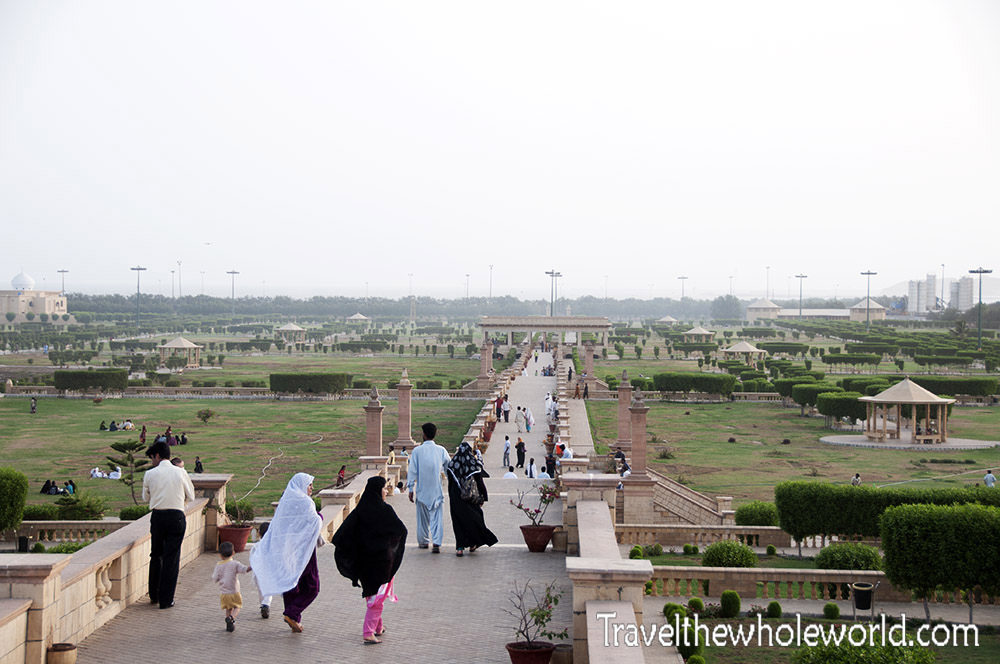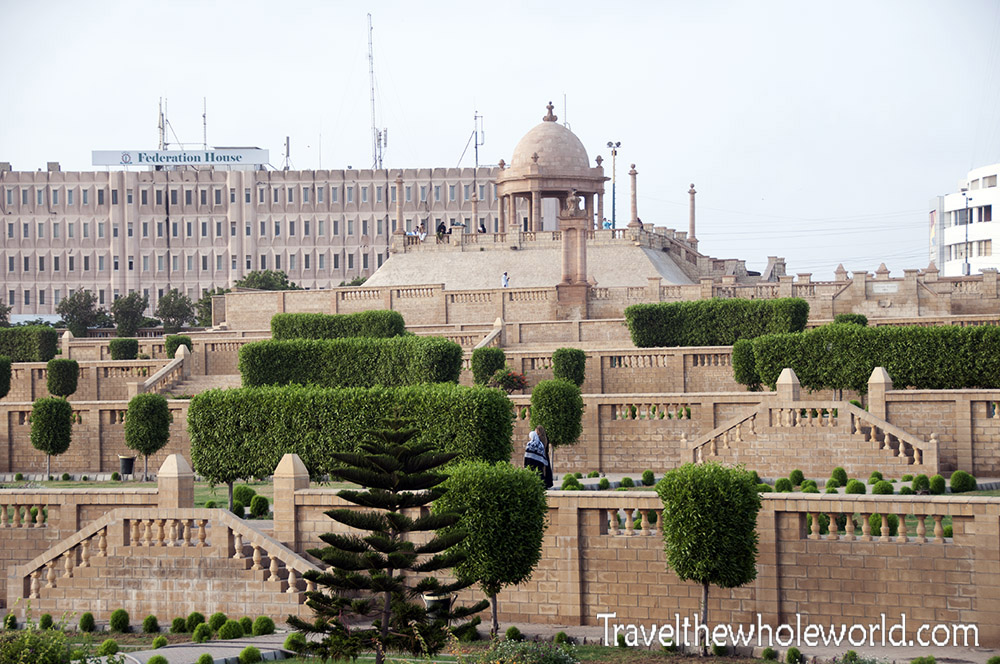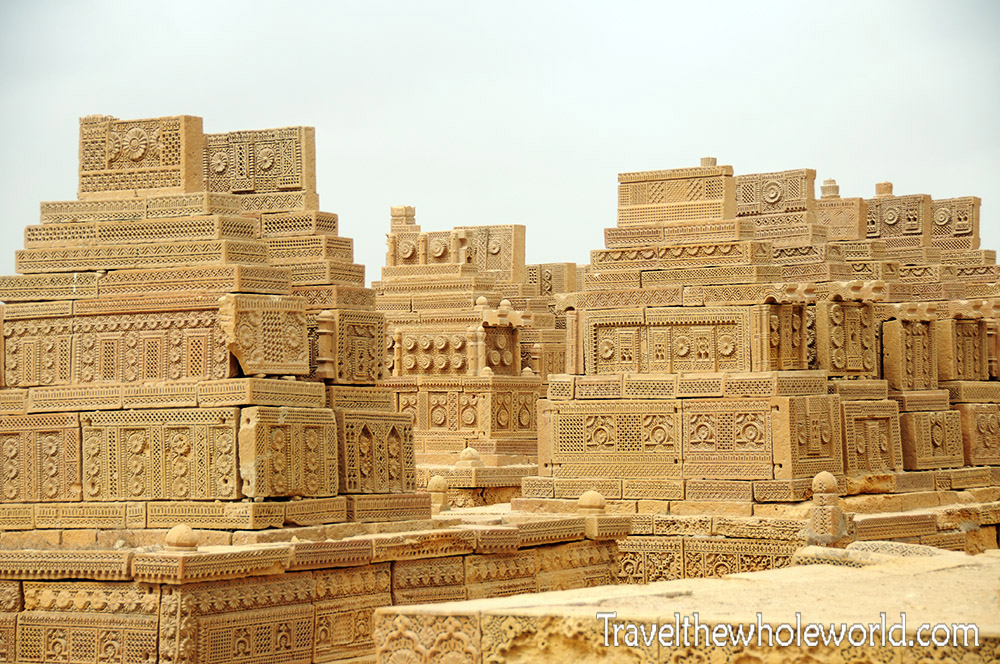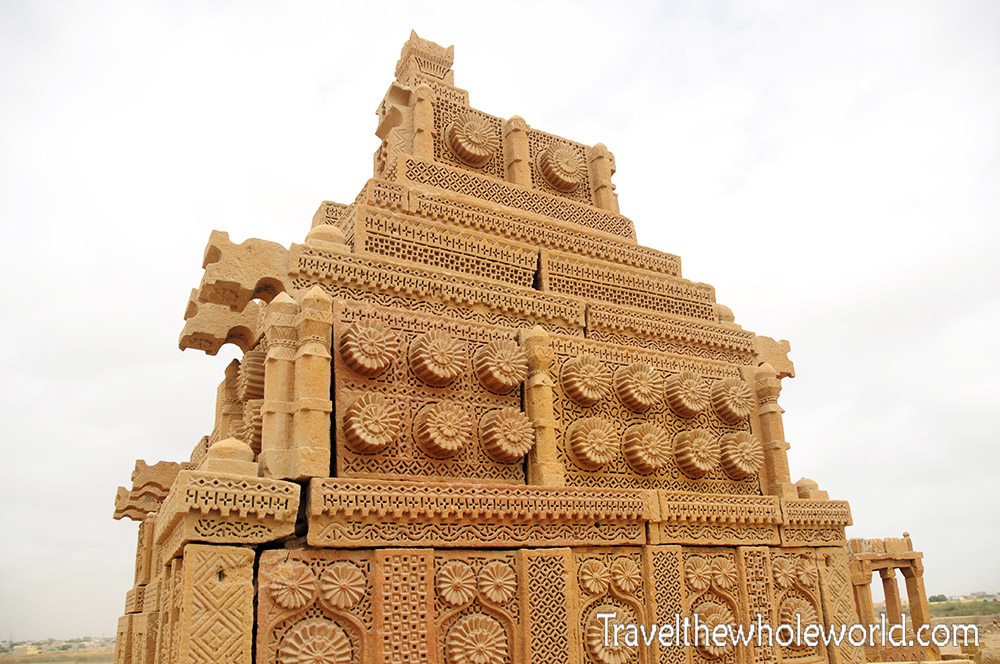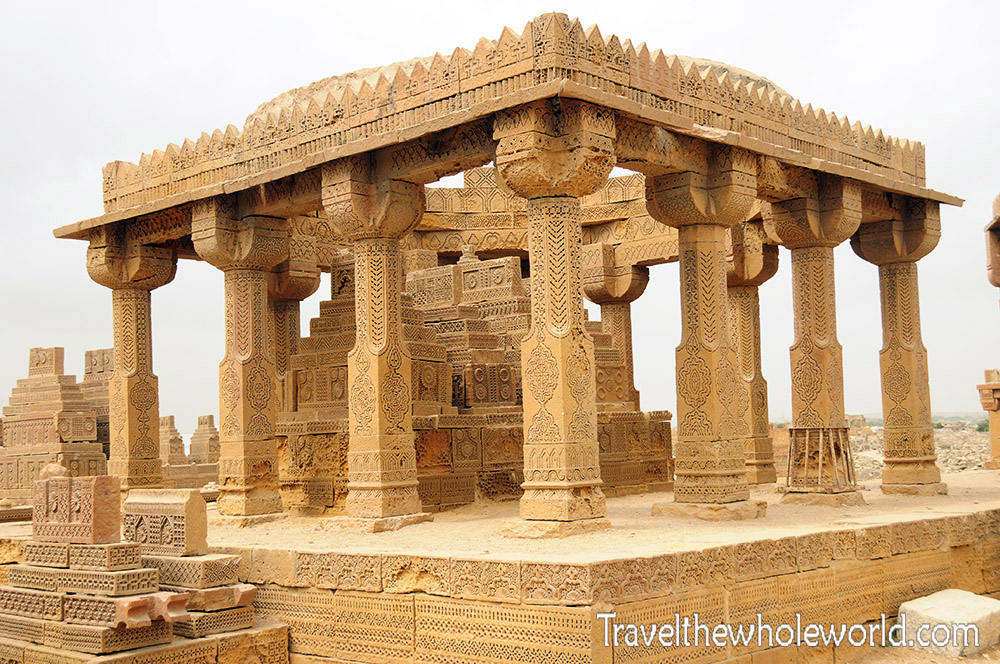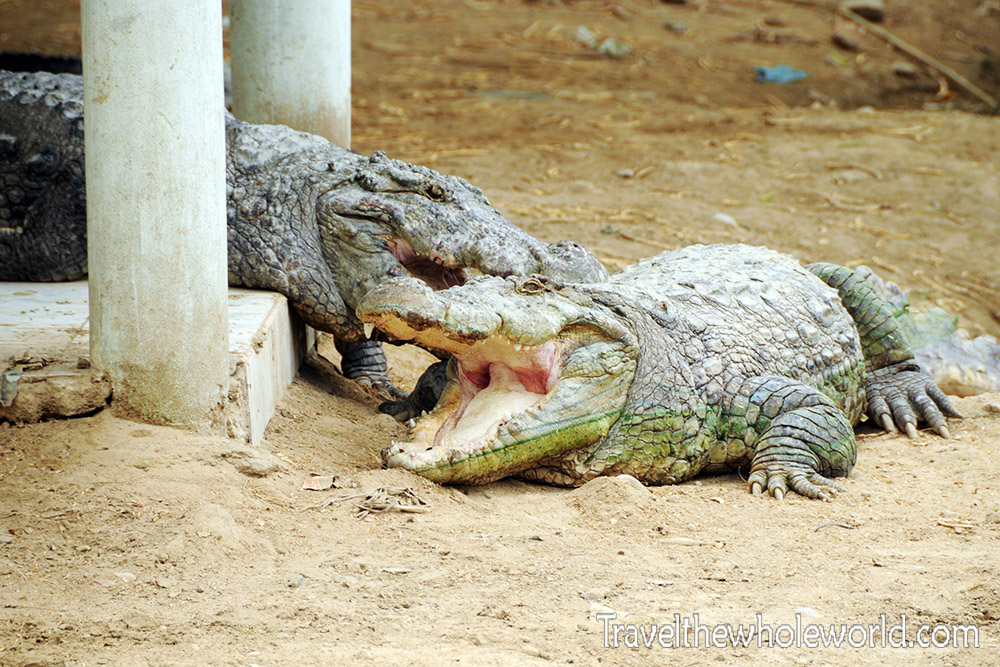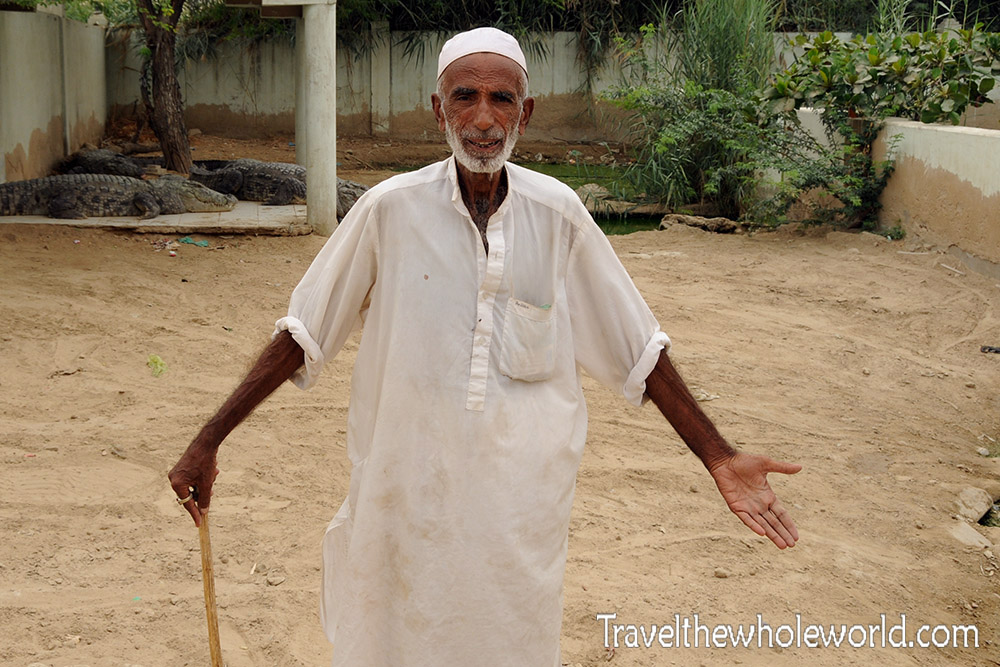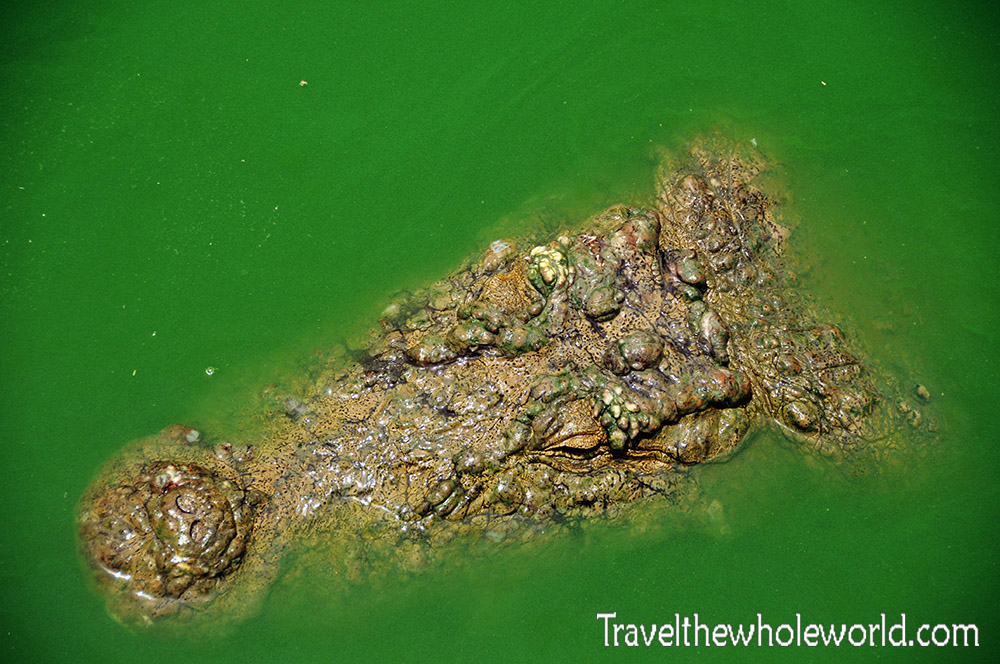Visiting Karachi
I started my Pakistan adventure from the port city of Karachi, one of the biggest and densest cities in the world. Lots of other cities are famous for their size such as New York or Tokyo, but what makes Karachi stand out is its population density. Karachi has an incredible 10,000 people per square kilometer! To put things in perspective, New York City’s metro area has 19 million people but if it had the same density as Karachi, its population would surpass 200 million! Despite its size Karachi lacks skyscrapers and seemed to be made up mostly large buildings and apartment blocks. The photo above is one of the larger and more modern buildings I saw in the city.
Karachi truly is a gigantic metropolis. You can find just about everything in the city you might want. As a matter of fact, when I first stepped off the airplane in Karachi the very first thing I saw outside the airport was a McDonald’s. While this McDonald’s was a different one, I took the picture to show some of the bright red hair styles I say in Karachi. I’ve seen people in other Muslim countries dye their hair brown which eventually fades to orange over time, but I’ve never seen such bright colors used.
Obviously in such a big city most of the population relies on public transportation. I’ve seen lots of crowded buses and jeeps during my travels in all parts of the country. This bus was driving around with its music blasting and a loud group of younger people riding inside as well as on top. It seemed more like a party bus rather than public transportation.
What I really liked about Pakistan was the effort people put into painting their trucks and buses. Some of them are incredibly detailed with artwork showing different parts of the country. Above is a close up of another truck showing some of the work people put into their vehicles. Many go beyond paintings and actually have chains and other items added to their trucks.
Like all major cities though, there are neighborhoods that are best avoided while there are other areas that are perfectly safe. A great place to visit that’s right in the city is Clifton Beach. Since Pakistan was more on the conservative side so I wasn’t sure what to expect here. There were thousands of people at the beach so it was pretty crowded. While plenty of people were swimming none were of course wearing bathing suits! The water was very warm so if you decide to take a swim here you won’t need to build up the will power to jump in.
Like any popular beach around the world there are several fun activities you can do here. You can take a ride along one of the dozens of camels roaming the beach. Another option is renting a dune buggy like this guy in the photo below.
As I was walking along the beach I stopped to purchase a souvenir. This must have gotten the attention of a younger guy who came up to me carrying a basket. I assumed he was trying to sell me more things and I politely gestured no thanks. He ignored me and put the basket on the ground and casually pulled out a cobra! I had never seen a snake charmer in my life and what better place than along the beaches of Pakistan. He entertained me and some other locals who came along. As a former snake owner I found this cobra to be strange. Most snakes seemed to want to get out a bit once you take them out their enclosure. This snake seemed to be happy where he was at and obediently followed his master while he played music. At first the snake even gave him a few strikes at his instrument but then calmed down. When he put the snake back into the basket it immediately coiled up and seemed content there rather than trying to escape.
These next two photos are also along the coast but far away from Clifton beach. This was my favorite area in Karachi and is known as “Paradise Point. The little island you see above used to bridge across to the left and formed a natural arch. The arch was famous for “Paradise Point but I was told it collapsed during a storm only a few years ago. Later on this trip when I made it to Lahore, I found an old post card of Paradise Point where the arch was still intact.
Maybe I didn’t spend enough time at Clifton beach, but for some reason it seemed Paradise Point was slightly less conservative. Almost half of the guys here were wearing shorts, and while kids always can get away with more, occasionally I’d even see a grown man without a shirt on.
When I visited a residential area along the coast I saw several pirate flags. I’m not sure if this was a joke or just a way to warn others not to trespass on their property! The photo below I got a better explanation from my driver. Different signs like these are painted over the city and represent a political party which seemed to be an important deal to Pakistanis. Most of the targeted assassinations in Karachi seem to be over politics rather than terrorism. Right before I arrived to Karachi it was on the news that there had been 18 assassinations throughout the city in a single day! My driver explained to me what some of the parties stood for, which ranged from good intentions to supporters of violence.
Speaking of security, one thing unique about Karachi was the locals were really open and seemed to be concerned with my safety. This started as soon as I arrived. My hotel who had arranged my driver for me, ordered him to have me back before the darkness every day, no exceptions. Even after I moved on from Karachi to other parts of Pakistan, many locals in the other cities told me they were scared to go to Karachi themselves! I played by the rules and had no problems of course. As far as the government goes, they seem to have very little tolerance for anyone doing anything weird. This warning sign about getting shot for trespassing was posted along a Pakistani air force base.
I ended up visiting a lot of museums in Karachi. When I had tried to visit the national museum the it was lost in translation and my driver ended up taking me here, to the Pakistani Maritime Museum instead. This place was fairly large with a nicely maintained park decorated with military equipment and vehicles. Inside the park they had a small canal and lake which is where the photo of this ship above was taken.
The Maritime museum also had a Pakistani submarine on display which you are free to explore yourself. This photo was taken from what I believe to be the engine room. Since I lived on an aircraft carrier for six months I was curious about exploring the submarine, but the thing was was ridiculously hot inside. Walking around the submarine felt like being in a sweat lodge, so my time was limited here!
The information was prettyinteresting and seemed to focus on Pakistan’s more recent history along with their relations with Britain. Plenty of other naval equipment was here including aircraft, missiles, rifles as well as colonial type ships and artwork and even a complete whale skeleton! Above is an enormous painting that depicted Pakistan during a naval battle while they were a British colony. The painting below shows Jinnah, the father of Pakistan, passing by naval troops during their independence ceremony from Britain in 1947.
The Maritime museum had a little bit of history regarding how India and Pakistan split from the British empire to form their own independent nations. I image the national museum would have a lot of information on this. The split let to some mass migrations as people had to choose to live in either Pakistan or India. This palace shows a bit of an example of that. This massive residence was built by a successful businessman in 1927 by the name of Shivratan Mohatta. Despite its size, this guy had so much money that this palace was just a summer home. When Pakistan became independent in 1947, Mohatta decided to permanently move to India and ended up abandoning this palace. The first leader of Pakistan, Muhammed Jinnah, had several of his relatives move into the Mohatta palace. After their lives were over, it was decided to turn the palace into a museum in the 1980’s. The palace was annoyingly closed for restoration, but I was at least allowed to walk through the gardens. Since I was limited to experiencing outside, I could only see what was in their gardens, such as these statues below.
The only reason I visited this place was because it caught my eye while driving. I thought this was a large cathedral in heart of Karachi. While those do exist, it turns out this building was actually the former British town hall. Like the Mohatta palace, this place was also turned into an art museum. I was pretty museumed out at this point but visiting was free and since I was already here there was no reason not to go. The building is known as Frere Hall, and below is a photo of its impressive ceiling painted by the famous artist Sadequain.
I felt the ratio of art to the massive size of this building was small, but the bottom floor is also the national library. The library is known as Liaquat Hall and has over 70,000 books, including some rare handwritten ones. As far as art goes, the most interesting artwork was definitely the ceiling. It’s hard to get perspective from the photo, but it’s at least 60 feet (20 meters) in length! Sadequain is said to be one of Pakistan’s greatest artists, and has received rewards from all over the world. He passed away when he was in his 60’s and left some paintings unfinished. Those glasses in the artwork above belonged to Sadequain. In the photo below is one last shot from the art gallery, though I’m not sure what it says or who created it.
I did try to go to the national museum a second time, mostly because my driver insisted on it. When we arrived this guy in the photo above was guarding the entrance. As I mentioned earlier, I had seen enough museums in Karachi so I wasn’t too sad when I was told it was closed. This guy guarding the gate repeatedly told me, “I am so so sorry”, then asked me to take his photo.
Another British structure that I passed by many times in Karachi was the Merewether Tower. This tower was built in 1884 and stands over 100 feet (30 meters) tall using medieval British architecture.
While I’m very satisfied with the museums and galleries I visited, I definitely missed out on some of Karachi’s night life and the popular district known as Port Grand. Port Grand is a new modern area in Karachi that is home to the city’s best restaurants, shopping and entertainment. That’s something I’ll have to fix next time I visit Karachi! As one of the largest cities in the world there pretty much isn’t anything Karachi doesn’t have. I did actually visit a place called the Arena, a large entertainment complex with dozens of family oriented activities. The photo above shows their bowling alley.
You basically have to go through security similar to an airport to get inside, but after that you’re free to do whatever you want. You’re not allowed to take photos inside but I asked if they could make an exception. I even had to go to the offices and meet with one of the managers who politely told me I could do whatever I wanted. I also tried to convince my driver to come inside with me but he refused. When I first met my driver, I had imagined us having a crazy experience in Karachi similar to Ferris Bueller’s day off. Unfortunately it wasn’t meant to be and sch a place isn’t as fun by yourself. I still tried the rock climbing wall and a few of the other games they had before I took off. Some other things available are the ice skating rink, bowling ally and more. They also have two restaurants inside the complex. I ate at the buffet and it was my best meal during my entire trip to Pakistan!
Thanks to the World Wildlife Federation much progress has been made in Pakistan regarding the care of ecosystems and recycling. I visited a WWF center in Karachi and was told this mangrove forest above was nearly non existent and covered in trash several years ago. Thanks to their restoration it’s now a place visited by locals, migratory birds, and even sea turtles. There are several WWF’s centers throughout the country that are run by locals.
The photo above was from a poster that shows some of their other work they have done; rescuing stranded dolphins and also helping to protect the species. The endangered Indus dolphin lives in the mountainous rivers of Pakistan. The waters of the Indus rivers are so murky that the Indus dolphins never properly developed eyesight and are considered to be blind!
The WWF wildlife area is probably the only nature park in Karachi. I had heard Qasim park was a place that I should definitely visit while here. This is an enormous park that is actually the largest city park in all of southern Asia! In the photo above you can see the gazebo like structure in the distance, that is actually just the center of the park.
I came here with my driver but we were both told we weren’t allowed to enter by the park by security. The reason why? We didn’t have a female with us! I found this to be strange but it was explained that this was a family park and single males weren’t allowed. I suppose that gives families and married couples here in Karachi a sanctuary from the rest of the city and makes sense. The guards were nice enough to give me permission to enter anyway. They are pretty serious about this rule, because another security guard stopped us and my driver had to explain the situation.
Lastly I visited two interesting cultural areas. In the northern outskirts of Karachi is an ancient Islamic cemetery known as Chaukhandi. These tombs range from 300 to 600 years old. When I first arrived to the cemetery I have to admit I was a bit disappointed. Because of Karachi’s traffic it took about an hour to get here. At a glance the cemetery seemed flat and unattractive. Once I began to explore I was taken back by the height of some of the tombs not to mention the detail that had been put into them. Some of the tombs are a few feet high while others are up to 14 feet (4 meters).
These tombs were decorated according to the gender. Male tombs generally had weapons on them while tombs of females had more peaceful symbols such as the flowers above. I’m not yet sure of the tomb in the photo below that has the structure over it. I assume these were some very important people, perhaps royalty several hundred years ago.
Another unique place that I visited in Karachi was the crocodile temple. Its local name is Pir Mangho Urs, and the temple is essentially a large pond surrounded by high walls and a gazebo inside. The only reason I came here was because my driver described the temple to me and it happened to be close to his home. I never understood the logic or reason, but he told me I’d have to come here with a lady otherwise we would have problems, so along the way he picked up his niece. The three of us arrived and I was invited inside the actual crocodile pit by the local man photographed below.
Every year there is a large festival that takes place at the temple, where people hold their screaming children above the crocodiles in order to bless them. If you don’t have children to bring then feeding the crocodiles by itself is said to bring good luck as well. It’s a good example of how local traditions blend in with religion. The green water is likely dyed because its the color of Islam and good luck. This practice has been going on here for over 800 years.
